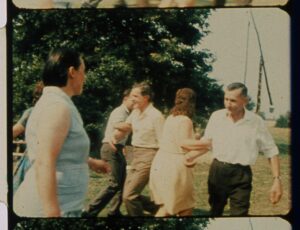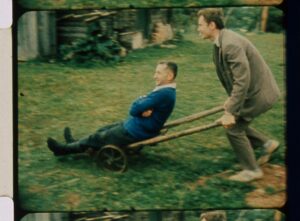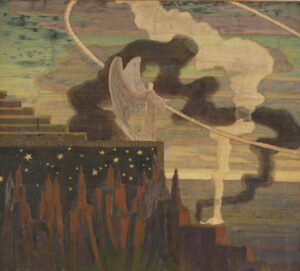Personal Reminiscences through Jonas Mekas and M.K. Čiurlionis

Reflecting on Jonas Mekas’ film, Reminiscences of a Journey to Lithuania (1972), I am reminded of my own journey to Lithuania and my encounter with M. K. Čiurlionis. Just as Mekas wove memories of his homeland with images of vast fields, humble villages, and lyrical landscapes, my discovery of Čiurlionis’ work created a tapestry of artistic and personal reflections. In the film, the soundtrack – featuring Professor Vytautas Landsbergis playing Čiurlionis’ piano preludes – served as an auditory echo of Lithuania’s soul, much like my own experiences intertwined music and landscape in my recollections of Lithuania.
THE BEGINNING
The first time I encountered Mikalojus Konstantinas Čiurlionis was serendipitous, a chance discovery in a small shop in Vilnius as I wandered through the old town. This journey, which began unexpectedly, has since become one of my life’s most cherished paths. I set out that summer as a student from Goldsmiths, University of London, travelling to meet a professor from Tokyo who was on a research trip to Riga. Yet, it was Lithuania – not Latvia – that resonated with me, drawing me toward its culture, its people, and most profoundly, its soul, embodied in the works of Čiurlionis. Jonas Mekas, the celebrated Lithuanian filmmaker and poet, wrote in one of his reflections: ‘Lithuania is Čiurlionis. Lithuania is also its folk songs which Čiurlionis so loved. Lithuania’s soul is very open, lyrical … a world that you can hold between your two palms. Small. Personal. Like a song.’ His words captured what I felt in those early days: that Lithuania had called me to see and understand its inner soul through the visions of its greatest artist and composer.
It was the summer of 2005. I hadn’t planned on meeting Čiurlionis or on what would become an enduring relationship with his music and art. My professor, a specialist in Latvian history, was travelling from Riga to Vilnius, and I accompanied her on a long bus journey. While she attended meetings, I explored Vilnius alone, discovering Čiurlionis’ works at a small CD shop. The connection I felt with his music was immediate and personal, as though a hidden part of my own soul had resonated with the spirit of his art. That initial encounter planted a seed of curiosity that would lead me back to Lithuania again and again, seeking to understand this artist who so clearly embodied the essence of his country.
It wasn’t until 2008 that I returned to Lithuania, this time with a specific purpose: to visit the M. K. Čiurlionis National Museum of Arte in Kaunas. For days, I immersed myself in the cultural landscapes of Vilnius and Kaunas, touring museums, historical sites, and even the Sugihara House. This journey only intensified my desire to delve deeper into Čiurlionis’ world, compelling me to seek a more comprehensive understanding of the man whose art seemed to bridge both physical and spiritual realms.
Mekas described Čiurlionis as ‘the dreamer who won’, an artist who, in Mekas’ poetic words, ‘risked his life to go to the very end of the arrow. He hit the mountain and exploded.’ Standing before Čiurlionis’ paintings, I could sense this intense vision – his aspiration to capture something both otherworldly and deeply rooted in the Lithuanian soul. This experience only solidified my decision to explore his life and work thoroughly, an endeavour that would bring me back to Lithuania multiple times over the following years.
To fully appreciate Čiurlionis, I knew I needed to learn his language. In 2008, back in Tokyo, I began studying Lithuanian under Professor Ikuo Murata, Japan’s foremost expert in the language. Learning Lithuanian felt like a vital step in connecting with Čiurlionis’ art on a cultural and linguistic level. Mekas’ words about Lithuania – ‘We, pantheists, loved our oak trees, our little snakes; we fed them with milk. We were always with nature, earth, all living things’ – echoed in my mind as I delved into this new linguistic journey. This step into the Lithuanian language was, for me, like stepping into the spirit of Čiurlionis’ Lithuania, allowing me to connect not only with his work but with the essence of the land and culture he so deeply loved.

Jonas Mekas. Sills from the film Reminiscences of a Journey to Lithuania, 1972. © Jonas Mekas. Courtesy of the Estate of Jonas Mekas
In 2009, I returned to Lithuania for an extended stay during a year of great significance for the nation. Vilnius had been designated the European Capital of Culture, and it marked the millennium since Lithuania’s first mention in ancient German texts. Determined to immerse myself fully, I arranged to study Lithuanian intensively at Vilnius University. This time, my visit was marked by a determination to understand Čiurlionis’ legacy as thoroughly as possible. His dedication to his homeland’s cultural heritage felt like a guiding spirit as I arrived in Vilnius.
From the moment I landed, I was enveloped in Lithuanian hospitality. A contact from an online forum met me at the airport, offered her home, and accompanied me to sites connected to Čiurlionis’ life. We visited Druskininkai, his childhood home, and Varėna, where he was born. Standing amidst the natural beauty of these places, I felt as though Čiurlionis himself were present, his spirit alive in the trees and rivers of his homeland. Mekas had written, ‘Ah, Lithuania is small. There are no big mountains in Lithuania. No big rivers. No dramatics. Its soul is very open, lyrical.’ In these surroundings, I felt that lyrical openness, a gentleness and intimacy, as though the landscape itself were sharing its stories with me. Lithuania indeed felt like a small world ‘you can hold between your two palms’, just as Mekas described.

Jonas Mekas. Sills from the film Reminiscences of a Journey to Lithuania, 1972. © Jonas Mekas. Courtesy of the Estate of Jonas Mekas
During my stay, I was fortunate to witness the Lithuanian Song and Dance Festival, an event held only every four years. Amidst the voices echoing folk songs that Čiurlionis himself had cherished, I felt a profound connection to the spirit of the nation. Mekas’ poetic line – ‘The shooter with the bow aims his arrow at the unknown. There is the mountain of destiny and dreams of humanity’ – seemed embodied in the gathering of voices and souls at this festival. This was where Čiurlionis’ music belonged – in the hearts of people gathered to celebrate their shared heritage.
Afterwards, I attended an organ concert by Juratė Landsbergytė at Vilnius’ only Lutheran church. The ethereal tones of her performance filled the church, weaving a timeless connection between Čiurlionis’ art and the Lithuanian landscape. At another concert in St. John’s Church at Vilnius University, I had the privilege of hearing Professor Vytautas Landsbergis play Čiurlionis’ piano works. Mekas’ words came to mind as I listened: ‘Landsbergis did not blink because he was aiming his arrow at the top of the mountain of destiny painted by Čiurlionis.’ In these performances, it felt as though the spirit of Čiurlionis lived on, inspiring others to reach for something beyond themselves.
Later, when listening to the soundtrack of Mekas’ Reminiscences of a Journey to Lithuania, I found myself transported back to the churches of Vilnius, where I had heard Professor Vytautas Landsbergis playing Čiurlionis’ piano works. The ethereal tones seemed to bridge time, connecting the Lithuania of Mekas’ memories to my own encounters with its art and music.
CHASING ČIURLIONIS’ FOOTSTEPS ACROSS LITHUANIA
In 2010, my journey took me further into the countryside. I travelled by bus to Plungė, where Čiurlionis had spent formative years studying music under Prince Michał Ogiński’s patronage. Plungė’s natural beauty was like an extension of his art. Visiting the manor where he studied, I imagined the young Čiurlionis discovering melodies within the surrounding forests and lakes.
Onward to Šateikiai, I stood in the church where Čiurlionis and his fianc.e, Sofija Kymantaitė, had married. The sense of reverence in the air was palpable, as if the walls held memories of his vows, of the dreams he shared with his bride. From there, I made my way to Rietavas, a town frequented by Čiurlionis during his studies and later as a flautist in Ogiński’s orchestra. Mekas’ words about Čiurlionis risking his life ‘to go to the very end of the arrow’ felt especially poignant here. I felt the weight of his journey, the devotion with which he had followed his artistic path.
The kindness of the people I met along the way was boundless. Locals who remembered the significance of Čiurlionis in their cultural heritage welcomed me with open arms. At the Rietavas museum, the curator even played a recording of Ogiński’s compositions and gifted me a CD, a memento that felt like a symbol of the warmth and generosity of Lithuania.
Returning to Vilnius, I spent my final days visiting markets and old bookstores in search of Čiurlionis memorabilia. I found rare postcards, stamps, and books – tiny fragments of history that I could carry home as reminders of this journey. Each item felt like a piece of Lithuania’s soul, a token of its enduring beauty. Mekas wrote, ‘The castles that grow into the sky. A world that you can hold between your two palms. Small. Personal. Like a song.’ Lithuania truly felt like a song – a song I could take with me, even as I left its borders.
One afternoon, my friends led me to a bust of Čiurlionis at The National M. K. Čiurlionis School of Art, a hidden tribute to a figure whose influence permeates every part of the city. It was a place I hadn’t known existed, yet finding it felt like uncovering a secret passage into Čiurlionis’ world. Standing there, I realised that this journey had become more than a pursuit of knowledge – it was a profound personal connection with a culture and its most cherished artist.
Alongside that, there was Mekas and the visual and auditory journey of his film. It resonates deeply with my experiences of Lithuania, where Čiurlionis’ art and music often felt like a background score to the picturesque landscapes. The piano preludes, in particular, brought to life the lyrical openness that Mekas described, reinforcing my own connection to this country and its cultural soul.
RETURNING ONCE MORE
In 2011, I returned once again, this time to Druskininkai for the centenary of Čiurlionis’ passing. As a guest of the Čiurlionis Society, I gave a presentation on Japanese influences in his work and the reception of his art in Japan. I spoke of how his symbolism and use of space echoed elements of Japanese aesthetics, something that resonated with the Lithuanian audience. Indeed, it was this connection that had drawn me here. Čiurlionis felt as close to Japan as he did to Lithuania, his pantheistic worldview creating bridges across cultures and continents.
After the conference, we visited the small church in Rietavas where Čiurlionis’ parents had married. Later, in Druskininkai, I wandered through the cemetery, finding the graves of his parents. Each place I visited seemed to hold an echo of him, as if his spirit had left traces in the Lithuanian landscape. It was a poignant reminder of how deeply Čiurlionis had become intertwined with the culture and identity of his homeland.
In the years that followed, I continued my research, tracing Čiurlionis’ life across Europe, from Kaunas to his apartment in Warsaw and a sanatorium near Warsaw where he spent his final days, and even to his apartment in Saint Petersburg. Walking through the streets he had known, standing before his former residence, I felt a quiet reverence. At the sanatorium near Warsaw, where Čiurlionis had stayed during his last days, I imagined the solitude and reflections that might have filled his mind. Mekas’ words came to mind: ‘The angels were watching and doing their work.’ Here, Čiurlionis’ journey ended, but his legacy had only begun.

Čiurlionis’ street in Warsaw, 2011
My journey with Čiurlionis eventually led me to Kaunas University of Technology, where, from 2013 to 2017, I committed myself to an indepth study of his life and work under the guidance of Professor Darius Kučinskas. My doctoral dissertation, titled ‘Contextuality of the Artistic Language of M. K. Čiurlionis: Links and Influences of Cultures of the East and the West Discovered in Čiurlionis’ Art’, examined his art as a bridge between Eastern and Western cultural influences. Mekas had written, ‘Čiurlionis risked his life to go to the very end of the arrow … He hit the mountain and exploded.’ Through this PhD journey, I came to see how Čiurlionis’ works conveyed the intensity of his aspirations, leaving fragments of his soul in every brushstroke. This dissertation was my attempt to honour Čiurlionis as both an artist and a visionary, bridging my traveller’s curiosity with the rigour of academic research.
Čiurlionis’ legacy continues to inspire artists and audiences alike. In Tokyo, the National Museum of Western Art will hold a Čiurlionis exhibition in spring 2026, a symbol of his enduring influence across continents. Mekas, reflecting on the connection between Japan and Lithuania, wrote, ‘Thank you, Vytautas Landsbergis, for introducing Čiurlionis to Japan. I think he will find a loving place in Japan because … Japan is also pantheistic, we are very close, Japan and Lithuania.’ This exhibition is a testament to the universality of Čiurlionis’ vision, and I am deeply grateful to have been part of a growing bridge between Japan and Lithuania.
CLOSING REFLECTIONS – LITHUANIA AS A SECOND HOME
As I look back on my experiences, I realise that my journey with Čiurlionis has transformed Lithuania into a second home, a place that, like Mekas’ words, ‘you can hold between your two palms.’ – a phrase I reflected on earlier. The quiet beauty of its landscapes, the warmth of its people, and the depth of its cultural soul have left an indelible mark on my heart. Reflecting further, I recall Mekas’ poignant observation: ‘The angels were watching and doing their work’ when Čiurlionis and Landsbergis embodied Lithuania’s soul and destiny. In a way, I feel as though those same angels guided me, as I wove my path through Lithuania’s fields, forests, and cities in search of Čiurlionis.
As we near the 150th anniversary of Čiurlionis’ birth, I reflect on how his legacy has influenced not only Lithuanian art but also global audiences. I am grateful for the memories and friendships that have accompanied me on this journey. Lithuania, with its open-hearted people and intimate landscapes, indeed feels ‘like a song’ that remains with me, wherever I go. This journey has allowed me to hold onto the wonder of a traveller while achieving the understanding and depth of a researcher, bridging the worlds of curiosity and scholarship.
In the end, my time in Lithuania has been more than a pursuit of knowledge. It has been a journey of the soul, guided by the voices of Lithuania’s past, and inspired by the lyrical, dreamlike world that Čiurlionis brought to life in his music and paintings. Mekas’ art and words resonate deeply with me because of their ability to bridge the personal and the universal. His film Reminiscences of a Journey to Lithuania, with its tender, fragmented vignettes, speaks to the heart of what it means to long for a homeland, even as one is distanced from it. The way he weaves Čiurlionis’ preludes into his narrative creates a powerful dialogue between memory and melody, evoking a sense of timelessness that mirrors my own search for connection. Mekas’ reflections, filled with a poetic sensibility and a profound understanding of human fragility, inspire me to look beyond the surface of things and explore the deeper currents of culture and identity. Through my studies, I have glimpsed what Mekas described as the ‘mountain of destiny and dreams of humanity’, and I feel honoured to be part of sharing Čiurlionis’ vision with the world.
*The quotes from Jonas Mekas’ poem in this article are taken from the preface he contributed in autumn 2008 to mark the Japanese edition of the book M. K. Čiurlionis: Time and Content by Vytautas Landsbergis, originally published by Lituanus in Vilnius in 1992.

M. K. Čiurlionis, The Offering, 1909, tempera on canvas
Yumiko Nunokawa. PhD, is a part-time lecturer at Waseda University, Tokyo. She earned her PhD from Kaunas University of Technology and her MMus from Goldsmiths College, the University of London. Her writing on composer Serge Prokofiev has been published in Three Oranges Journal of the Serge Prokofiev Foundation, London in 2008 and 2012. In 2009, she contributed to the publication of the Japanese edition of Prof. Vytautas Landsbergis’s book Čiurlionis: Time and Content. In 2011 she assisted as a producer and translator for Čiurlionis Piano Works (URTEXT), compiled by Prof. Darius Kučinskas and published by Yamaha. Since 2010, she has been a regular participant in Čiurlionis-themed conferences. Her research interests include M. K. Čiurlionis, Lithuanian folk song music, the synthesis of the arts in fin-de-si.cle Europe, and Japonisme.


